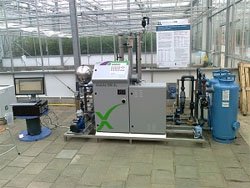Research initiated by the Platform for Sustainable Greenhouse Horticulture has identified three water purification techniques that can remove 80 to 100% of crop protection products from discharge water from the greenhouse horticulture sector. These techniques can therefore help to further improve surface water quality in horticultural areas, which will help to maintain the availability of crop protection products for the sector.
The Innovation and Demonstration Centre (IDC) Water at Wageningen UR Greenhouse Horticulture studied four purification techniques in the past year with a view to assessing their effectiveness and applicability in practice. On the basis of selection criteria, these technologies were chosen from a long list compiled by independent experts from the Dutch water sector (from KWR, Wetsus, Mannen van de WIT and the Delfland District Water Board) and representatives from the greenhouse horticulture sector.
The four techniques are as follows:
• ozone with and without an active carbon filter
• hydrogen peroxide + low pressure UV
• hydrogen peroxide + medium pressure UV
• electrochemical flocculation.
The techniques were tested on a semi-practical scale using Standard Water, a standardised horticultural discharge water containing commonly found levels of nutrients, suspended solids and twelve different crop protection products. A comparison using discharge water from a rose nursery was also conducted.
Results
With ozone (without carbon filter) and with hydrogen peroxide + UV (low pressure and medium pressure), an average purification yield of 80% is achieved. The breakdown for individual substances was sometimes higher, sometimes lower. If ozone is used in combination with an active carbon filter, a purification rate of 100% can be achieved under short-term loading. However, under long-term loading a breakthrough of the carbon filter will start so the purification yield will decrease. Filters therefore need to be changed regularly. An active carbon filter can also be used in combination with the other techniques.
In terms of applicability in horticulture, there is little to choose between the three techniques: the prospects for application are generally good. However, there are some small points of concern regarding safety in the use of oxidation chemicals.
Cost calculations (reported by the technology suppliers themselves) show that hydrogen peroxide + low pressure UV is the cheapest technique, and ozone (without carbon filter) the most expensive. For a five-hectare nursery, the annual costs range from 1.00 to 2.70 euros per m3 and from just under 9 to 17 cents per m2, depending on the volume of water discharged and the technique used.
Using an active carbon filter adds around 30-80 cents per m3 and 3-4 cents per m2, assuming filters are changed every two years.
Electrochemical flocculation gave a purification yield of approximately 40%. This technique proved unsuitable in the current pilot set-up but may become an attractive prospect after further development.
Follow-up
Follow-up research will aim to optimise the combination of an active carbon filter and oxidation techniques, with a focus on costs and effectiveness. In addition, further new purification techniques will be tested at IDC Water.
The project ’Evaluatie technologieën voor zuivering spui’ (‘Evaluation of Technologies for Treatment of Drain Water’) was carried out by Wageningen UR Greenhouse Horticulture and the Netherlands Water Partnership on behalf of the Platform Duurzame Glastuinbouw (PDG), (Sustainable Greenhouse Horticulture). The sponsors of the project, represented on the Steering Committee, are the Product Board for Horticulture, Dutch Ministry of Economic Affairs, Dutch Ministry of Infrastructure and the Environment, Delfland District Water Board, Schieland and Krimpenerwaard District Water Board, Evides Waterbedrijf, Syngenta, Bayer, BASF and Certis.
Fonte: Wageninge UR - 18 marzo 2013,
